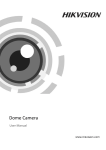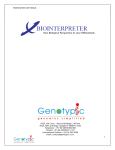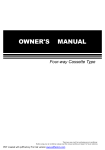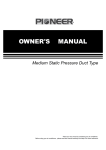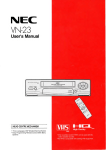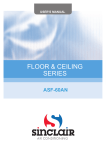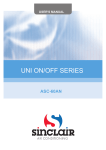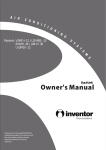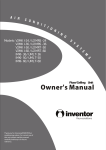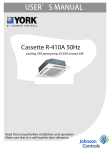Download FULL DC INVERTER SYSTEMS - sinclair air conditioners
Transcript
FULL DC INVERTER SYSTEMS OWNER‘S MANUAL Indoor Units COMMERCIAL AIR CONDITIONERS SDV4 Original instructions CAUTION Put the louver horizontally when cooling. Do not disconnect the power. Do not disconnect the power. There will be water condensing on the louvers if setting the louvers down when cooling. (Cassette type only) Do not disconnect the power when the unit is in operation. Please control it with the remote controller. Place it away from TV or radio. Connect to the power 12 hours before starting the unit 12 hours before Put the TV or radio away from the air conditioner at least 1 meter, or signal will be interfered. To protect the compressor, please turn on the power switch 12 hours before starting the unit. One of the indoor units can not run on the cooling mode while the other indoor units run on the heating mode. Please run every indoor unit on the same mode. 5 CONTENTS PAGE IMPORTANT SAFETY INFORMATION..........................................................1 PARTS NAMES..........................................................................................2 AIR CONDITIONER OPERATIONS AND PERFORMANCE..............................5 ADJUSTING AIR FLOW DIRECTION............................................................6 MAINTENANCE.........................................................................................10 FOLLOWING SYMPTOMS ARE NOT AIR CONDITIONER TROUBLES.........13 TROUBLESHOOTING................................................................................14 It is not good for your health to expose your body to the air flow for a long time. Do not insert fingers, rods or other objects into the air inlet or outlet. When the fan is rotating at high speed, it will cause injury. Never use a flammable spray such as hair spray, lacquer or paint near the unit. It may cause a fire. Never touch the air outlet or the horizontal blades while the swing flap is in operation. Fingers may become caught or the unit may break down. Never put any objects into the air inlet or outlet. Objects touching the fan at high speed can be dangerous. Never inspect or service the unit by yourself. Ask a qualified service person to perform this work. Do not dispose this product as unsorted municipal waste. Collection of such waste separately for special treatment is necessary. 1. IMPORTANT SAFETY INFORMATION To prevent injury to the user or other people and property damage, the following instructions must be followed. Incorrect operation due to ignoring of instructions may cause harm or damage. The safety precautions listed are divided into two categories. In either case, important safety information is listed which must be read. WARNING Failure to observe a warning may result in death. The appliance shall be installed in accordance with national wiring regulations. CAUTION Failure to observe a caution may result in injury or damage to the equipment. WARNING Ask your dealer for installation of the air conditioner. Incomplete installation performed by yourself may result in a water leakage, electric shock, and fire. Do not dispose of electrical appliances as unsorted municipal waste, use separate collection facilities. Contact you local government for information regarding the connection systems available. If electrical appliances are disposed of in landfills or dumps, hazardous substances can leak into the groundeater and get into the food chain, damaging your health and well-being. To prevent refrigerant leak, contact your dealer. When the system is installed and runs in a small room, it is required to keep the concentration of the refrigerant, if by any chance coming out, below the limit. Otherwise, oxygen in the room may be affected, resulting in a serious accident. The refrigerant in the air conditioner is safe and normally does not leak. If the refrigerant leaks in the room, contact with a fire of a burner, a heater or a cooker may result in a harmful gas. Turn off any combustible heating devices, ventilate the room, and contact the dealer where you purchased the unit. Do not use the air conditioner until a service person confirms that the portion where the refrigerant leaks is repaired. Ask your dealer for improvement, repair, and maintenance. Incomplete improvement, repair, and maintenance may result in a water leakage, electric shock, and fire. In order to avoid electric shock, fire or injury, or if you detect any abnormality such as smell of fire, turn off the power supply and call your dealer for instructions. Never let the indoor unit or the remote controller get wet. It may cause an electric shock or a fire. Never press the button of the remote controller with a hard, pointed object. The remote controller may be damaged. Never replace a fuse with that of wrong rated current or other wires when a fuse blows out. Use of wire or copper wire may cause the unit to break down or cause a fire. CAUTION Do not use the air conditioner for other purposes. In order to avoid any quality deterioration, do not use the unit for cooling precision instruments, food, plants, animals or works of art. Before cleaning, be sure to stop the operation, turn the breaker off or pull out the supply cord. Otherwise, an electric shock and injury may result. owner’s manual 1 In order to avoid electric shock or fire, make sure that an earth leak detector is installed. Be sure the air conditioner is grounded. In order to avoid electric shock, make sure that the unit is grounded and that the earth wire is not connected to gas or water pipe, lightning conductor or telephone earth wire. In order to avoid injury, do not remove the fan guard of the outdoor unit. 2. PARTS NAMES ■ Four-way cassette type Air Out Louver (Adjustable) Two-direction or Three-direction Air Outlet For the detailed information please consult your local dealer. Grounding Screw (In the control box) Do not operate the air conditioner with a wet hand. An electric shock may happen. Do not touch the heat exchanger fins. These fins are sharp and could result in cutting injuries. Lock buckle (For closing the Air Grille) Do not place items which might be damaged by moisture under the indoor unit. Condensation may form if the humidity is above 80%, the drain outlet is blocked or the filter is polluted. Air Intake (Intake air from here) After a long use, check the unit stand and fitting for damage. If damaged, the unit may fall and result in injury. Air Filter (Filter the dust in the intake air) To avoid oxygen deficiency, ventilate the room sufficiently if equipment with burner is used together with the air conditioner. Arrange the drain hose to ensure smooth drainage. Incomplete drainage may cause wetting of the building, furniture etc. Never touch the internal parts of the controller. Do not remove the front panel. Some parts inside are dangerous to touch, and a machine trouble may happen. Fig.2-1 ■ Ceiling-floor type Air Outlet Horizontal Louver Never expose little children, plants or animals directly to the air flow. Adverse influence to little children, animals and plants may result. Do not allow a child to mount on the outdoor unit or avoid placing any object on it. Falling or tumbling may result in injury. Do not operate the air conditioner when using a room fumigation - type insecticide. Failure to observe could cause the chemicals to become deposited in the unit, which could endanger the health of those who are hypersensitive to chemicals. Do not place appliances which produce open fire in places exposed to the air flow from the unit or under the indoor unit. It may cause incomplete combustion or deformation of the unit due to the heat. Do not install the air conditioner at any place where flammable gas may leak out. If the gas leaks out and stays around the air conditioner, a fire may break out. The appliance is not intended for use by young children or infirm persons without supervision. NOTE All the pictures in this manual are for explanation purpose only. They may be slightly different from the air conditioner you purchased(depend on model). The actual shape shall prevail. owner’s manual 2 Air Intake (Intake room air here) Air Filter (Filter the dust in the air) Fig.2-2 ■ Wall-mounted type Air Intake (Intake room air here) ■ High static pressure duct type Grounding Screw (In the control box) Heat Exchanger (Exchange cool air into warm air) Air Outlet (Outlet room air) Air Outlet Horizontal Louver (Adjust the air-out directions. ) Air Filter (Filter the dust in the air) Electric control box Fig.2-5 Air Intake (Intake room air here) One refrigerant system Fig.2-7 ■ Duct/ceiling type Air Intake (Intake room air here) Air Outlet (Connect the duct) Air Outlet (Outlet room air) Grounding Screw (In the control box) Air Intake (Intake room air here) Air Filter (Filter the dust in the air) Lock Buckle (For closing the air intake grille) Electric control box B Electric control box A Two refrigerant system Fig.2-8 Fig.2-6 ■ (Thin) Duct/ceiling type Air Outlet (Outlet room air) Heat Exchanger (Exchange cool air into warm air) Air Intake (Intake room air here) Fig.2-9 owner’s manual 3 Indoor unit Low-pressure pipe Outlet pipe Connecting pipe Hi-pressure pipe Inlet pipe Throttle part Electric control box Fig.2-10 ■ Middle static pressure duct type Air Intake (Intake room air here) Electric control box Air Outlet (Outlet room air) Heat Exchanger (Exchange cool air into warm air) Fig.2-11 ■ Low static pressure type Air Outlet (Connect the duct) Grounding Screw (In the control box) Control Box Air Intake (Intake room air here) Air Filter (Filter the dust in the air) Fig.2-12 owner’s manual 4 3. AIR CONDITIONER OPERATIONS AND PERFORMANCE Use the system in the following temperature for safe and effective operation. The Max operation temperature for the air conditioner.(Cooling/Heating) Table 3-1 Temperature Mode Indoor temperature 17°C ~ 32°C Cooling operation Heating operating (cooling only type without) NOTE 1 If air conditioner is used outside the above conditions, it may cause the unit to function abnormally. 2 The phenomenon is normal that the surface of air conditioning may condense water when the relative larger humidity in room, please close the door and window. 3 Optimum performance will be achieved within these operating temperature range. 4 Protection device will be activated and the unit stops when the above conditions can not satisfy. Indoor Humidity Below 80% 80% humidity or above will cause the machine surface condensing dew. ≤27°C Please note the following correct operation for saving energy and achieve the quick and comfortable cooling/heating effects. ● The blocked air filter will reduce cooling/heating effects. check regularly ● Close the door/window Do not let the heat/cool air leak from the door/widow. close the door/window ● Do not overcool or overheat. Do not expose you to the cool wind for a long time. Over-cool is harm to your health. Especially for the handicapped, children or older. Do not overcool owner’s manual 5 ● To maintain the comfortable temperature. When using the panel with auto.louver, press SWING button , the auto, louver will swing automatically and the best cooling (heating) effects will be achieved. Adjust the air-out direction with using the air-out louver. 4. ADJUSTING AIR FLOW DIRECTION. Because cold air flow down and hot air flow up,to improve the the cooling and heating effect, please adjust air flow louver direction, in result the temperature of the room will be natural and equal and you will fell more comfortable. NOTE 1 The heating operation with horizontal air outlet will increase the difference of the room temperature. 2 The louver direction : Choose horizontal outlet mode when cooling operation When the cooling operation,the air flow down will cause condensing dew on the air outlet and louver surface. ■ Four-way cassette type ● Cooling operation Adjust the louver horizontally . Fig.4-1 ● Heating operation Adjust the louver down. Fig.4-2 owner’s manual 6 ■ Duct-ceiling type The following is how to adjust the air flow direction when the air outlet parts (sold separiN ately) is used with the indoor unit. ● When cooling To effectively heat the bottom of the room please set the louver downwards. (Fig.4-9) ● When heating To effectively heat the bottom of the room please set the louver downwards. (Fig.4-10) Fig.4-9 ■ Fig.4-10 Wall-Mounted type Adjust the Air Flow Direction Up and Down ● Auto-swing Press SWING button, the louver will swing up and down automatically. Fig.4-11 ● Manual swing Adjust the louver to achieve the better cooling/ heating effects when cooling/heating. ● When cooling Adjust the louver horizontally. Fig.4-12 ● When heating Adjust the louver downwards (vertically). Fig.4-13 owner’s manual 7 CAUTION 1 Water drop may be caused on the surface of the unit or horizantal louver when cooling while the air-out direction is vertically down. 2 Indoor temperature will not be even on the heating mode when the air-out direction is horizontal. 3 Do not move the horizontal louver with hands, or malfunction may occur. Adjust it with the swing button on the wire controller. ■ Ceiling-floor type ● Auto-swing Press SWING button, the louver will swing up and down (left and right) automatically. Fig.4-14 ● Manual swing Adjust the louver to achieve the better cooling/ heating effects when cooling/heating. ● When cooling Adjust the louver horizontally. Fig.4-15 ● When heating Adjust the louver downwards (vertically). Fig.4-16 owner’s manual 8 5. MAINTENANCE CAUTION ■ 1 Before you clean the air conditioner, be sure the power supply is off. 2 Check if the wiring is not broken off or disconnected. 3 Use a dry cloth to wipe the indoor unit and remote controller. 4 A wet cloth may be used to clean the indoor unit if it is very dirty. 5 Never use a damp cloth on the remote controller. 6 Do not use a chemically-treted duster for wiping or leave such material on the unit for long. it may damage or fade the surface of the unit. 7 Do not use benzine, thinner, polishing powder, or similar solvents for cleaning. These may cause the plastic surface to crack or deform. The control box cables, which are originally connected with the main body electrical terminators must be pulled off before doing as indicated above. Push the grill switches to the arrow directions, then open the air-in grill downwards. Turn back the air filter fixing block, then take out the air-in grill. ● The air filter can prevent the dust or other parcticles from going inside. In case of blockage of the filter, the working effeciency of the air conditioner may greatly decrease, therefore, the filter must be cleaned once two weeks during long time using. ● If the air conditioner is positioned in a dust place, the cleaning frequency of the air filter must be increased. ● If the accumulated dust is too heavy to be cleaned, please replace the filter with a new one(the replaceable air filter is an optional fitting). 1. Take out the air-in grill ● For Four- Way Cassette Type Push the grill switches towards the middle simultaneously as indicated in Sketch Fig.5-1 . Then pull down the air- in grill. Take out the air-in grill (together with the air filter shown in Sketch Fig.5-2). Pull the air-in grill down at 45° and lift it up to take out the grill. Fig.5-1 10 CAUTION ● For Duct/Celling Type Method for cleaning the air filter owner’s manual Fig.5-2 2. Dismantle the air filter. Maintenance before a long stop period 3. Clean the air filter (eg. at the end of the season) The air filter can prevent the dust or other particulate from going inside .In case of blockage of the filter , the working efficiency of the air conditioner may greatly decrease . Therefore , the filter must be cleaned once two weeks during long time usage. Let the indoor units run in fan only operation for about half a day in order to dry the interior of the units. Clean air filters and casings of indoor units. Clean the air filter with vacuum cleaner or water. Refer to “Cleaning the air filter" for details on how to proceed and make sure to install cleaned air filters back in the same position. a.The air-in side should face up when using vacuum cleaner. (Refer to Fig.5-13) b.The air-in side should face down when using clean water. (Refer to Fig.5-14) Turn off the unit with the “ON/OFF” button on the remove controlller,then disconnect the power. If the dust accumulation is too heavy, please use soft bursh and natural detergent to clean it and dry in the cool place. NOTE When the power switch is connected, some energy will be consumed, even if the unit is not in operation. So please disconnect the power to save the energy. A degree of filth will be accumulated due to certain performance after several seasons of operation. So special maintenance is advised. Take out of the batteries from the remove controller. Fig.5-13 Maintenance after a long stop period (eg. at the beginning of the season) Check and remove everything that might be blocking inlet and outlet vents of indoor units and outdoor units. Clean air filters and casings of indoor units. Refer to "Cleaning the air filter" for details on how to proceed and make sure to install cleaned air filters back in the same position. Fig.5-14 Turn on the power at least 12 hours before operating the unit in order to ensure smoother operation. As soon as he power is turned on, the remote controller displays appear. Digital scroll central air conditioning auxiliary heating equipment CAUTION 1 Do not dry out the air filter under direct sunshine or with fire. In winter, due to the difference of the area and building construction, please purchase the indoor unit with auxillary heating to enlarge the capacity. When turning to the heat mode the air conditioner with auxiliary heating will run at the set term. It’s no install auxiliary heating equipments on site for 4-way cassttte type and duct/celling type(with auxiliary heating). 4. Re-install the air filter. 5. Install and close the air-in grill in the reverse orders of step 1 and 2 and connect the control box cables to the corre sponding terminators of the main body. owner’s manual 12 6. FOLLOWING SYMPTOMS ARE NOT AIR CONDITIONER TROUBLES Symptom 1: The system does not operate The air conditioner does not start immediately after the ON/OFF button on the romote controller is pressed. If the operation lamp lights, the system is in normal condition.To prevent overloading of the compressor motor, the air conditioner starts 3 minutes after it is turned ON. If the operation lamp and the "PRE-DEF indicator(cooling and heating type) or fan only indicator(cooling only type)" light, it means you choose the heating model, When just starting, if the compressor has not started, the indoor unit appears "anti cold wind" protection because of its overlow outlet temperature. Symptom 2: Change into the fan mode during cooling mode In order to prevent the indoor evaporator frosting, the system will change into fan mode automatically, restore to the cooling mode after soon. . When the room temperature drops to the set temperature, the compressor goes off and the indoor unit changes to fan mode; when the temperature rises up, the compressor starts again. It is same in the heating mode. Symptom 3: White mist comes out of a unit Symptom 4.2: Indoor unit, outdoor unit A continuous low hissing sound is heard when the system is in operation. This is the sound of refrigerant gas flowing through both indoor and outdoor units. A hissing sound which is heard at the start or immediately after stopping operation or defrost operation. This is the noise of refrigerant caused by flow stop or flow change. Symptom 4.3: Outdoor unit When the tone of operating noise changes. This noise is caused by the change of frequency. Symptom 5: Dust comes out of the unit When the unit is used for the first time in a long time. This is because dust has gotten into the unit. Symptom 6: The units can give off odours The unit can absorb the smell of rooms, furniture, cigarettes, etc., and then emit it again. Symptom 7: The outdoor unit fan does not spin. During operation. The speed of the fan is controlled in order to optimize product operation. Symptom 3.1: Indoor unit When humidity is high during cooling operation If the interior of an indoor unit is extremely contaminated, the temperature distribution inside a room becomes uneven. It is necessary to clean the interior of the indoor unit. Ask your dealer for details on cleaning the unit. This operation requires a qualified service erson Symptom 3.2: Indoor unit, outdoor unit When the system is changed over to heating operation after defrost operation Moisture generated by defrost becomes steam and is exhausted. Symptom 4: Noise of air conditionerscooling Symptom 4.1: Indoor unit A continuous low "shah" sound is heard when the system is in cooling operation or at a stop. When the drain pump (optional accessories) is in operation,this noise is heard. A "pishi-pishi" squeaking sound is heard when the system stops after heating operation. Expansion and contraction of plastic parts caused by temperature change make this noise. owner’s manual 13 7. 7.1 TROUBLESHOOTING Troubles and causes of air conditioner If one of the following malfunctions occur, stop operation, shut off the power, and contact with your dealer. Remote controller receives malfunction or the button does not work well. A safety device such as a fuse, a breaker frequently actuates. Obstacles and water enter the unit. Water leaks from indoor unit. Other malfunctions. If the system does not properly operate except the above mentioned cases or the above mentioned malfunctions is evident, investigate the system according to the following procedures. (See in Table 7-1) Table 7-1 Symptoms Causes Solution Unit does not start Power failure. Power switch is off. Fuse of power switch may have burned. Batteries of remote controller exhausted or other problem of controller. Wait for the comeback of power. Switch on the power. Replace the fuse. Replace the batteries or check the controller. Air flowing normally but completely can't cooling Temperature is not set correctly. Be in 3 minutes protection compressor. Set the temperature properly. Wait. of Refrigerant is too little or too much. Units start or stop frequently Low cooling effect Air or no concreting gas in the refrigerating circuit. Compressor is malfunction. Voltage is too high or too low. System circuit is blocked. Outdoor unit and indoor unit heat exchanger is dirty. The air filter is dirty. Inlet/outlet of indoor/outdoor units is blocked. Doors and windows are open Sunlight directly shine. Too much heat resource. Outdoor temp. is too high. Leakage of refrigerant or lack of refrigerant. Low heating effect owner’s manual 14 Outdoor temperature is lower than 7°C. Doors and windows not completely closed. Leakage of refrigerant or lack of refrigerant. Check leakage, and rightly recharge refrigerant. Vacuum and recharge refrigerant. Maintenance or change compressor. Install manostat. Find reasons and solution. Clean the heat exchanger. Clean the air filter. Eliminate all dirties and make air smooth. Close doors and windows. Make curtains in order to shelter from sunshine. Reduce heat source. AC cooling capacity reduces (normal). Check leakage and rightly recharge refrigerant. Use heating device. Close doors and windows. Check leakage and rightly recharge refrigerant. 7.2 Troubles and causes of remote controller Before asking for serving or repairing, check the following points.(See in Table 7-2) Table 7-2 Symptoms The fan speed can not be changed. Causes Solution Check whether the MODE indicated on the display is "AUTO" When the automatic mode is selected, the air conditioner will automatically change the fan speed. Check whether the MODE indicated on the display is "DRY" When dry operation is selected, the air conditioner automatically change the fan speed. The fan speed can be selected during "COOL" , "FAN ONLY", and "HEAT". The remote controller signal is not transmitted even when the ON/OFF button is pushed. Check whether the batteries in the remote controller are exhausted. The TEMP. indicator does not come on. Check whether the MODE indicated on the display is FAN ONLY The temperature cannot be set during FAN mode. Check whether the timer operation has come to an end when the TIMER OFF is indicated on the display. The air conditioner operation will stop up to the set time. Check whether the timer operation is started when the TIMER ON is indicated on the display. Up to the set time, the air conditioner will automatically start and the appropriate indicator will go off. Check whether the signal transmitter of the remote controller is properly directed to the infrared signal receiver of the indoor unit when the ON/OFF button is pressed. Directly transmit the signal transmitter of the remote controller to the infrared signal receiver of the indoor unit, and then repeatly push the ON/OFF button twice. The indication on the display disappears after a lapse of time. The TIMER ON indicator goes off after a lapse of certain time. No receiving tone sounds from the indoor unit even when the ON/OFF button is pressed. The power supply is off. owner’s manual 15 NOTE CONCERNING PROTECTION OF ENVIRONMENT This product must not be disposed of via normal household waste after its service life, but must be taken to a collection station for the recycling of electrical and electronic devices. The symbol on the product, the operating instructions or the packaging indicate such disposal procedures. The materials are recyclable in accordance with their respective symbols. By means of re-use, material recycling or any other form of recycling old appliances you are making an important contribution to the protection of our environment. Please ask your local council where your nearest disposal station is located. INFORMATION CONCERNING USED REFRIGERANT MEDIUM This unit is containing fluorinated gases included in the Kyoto protocol. The maintanance and the liquidation must be carried out by qualified personel. Type of refrigerant: R410A The composition of the cooling medium R410A: (50% HFC-32, 50% HFC-125) The quantity of the refrigerant: please see the unit label. The value GWP: 2088 GWP = Global Warming Potential In case of quality problem or other please contact your local supplier or authorized service center. Emergency number: 112 PRODUCER Producer: SINCLAIR CORPORATION Ltd., 1-4 Argyll St., London W1F 7LD, UK, www.sinclair-eu.com This product was manufactured in China (Made in China). REPRESENTATIVE AND TECHNICAL SUPPORT NEPA spol. s r.o. Purkyňova 45 612 00 Brno Czech Republic Tel.: +420 800 100 285 www.nepa.cz


















